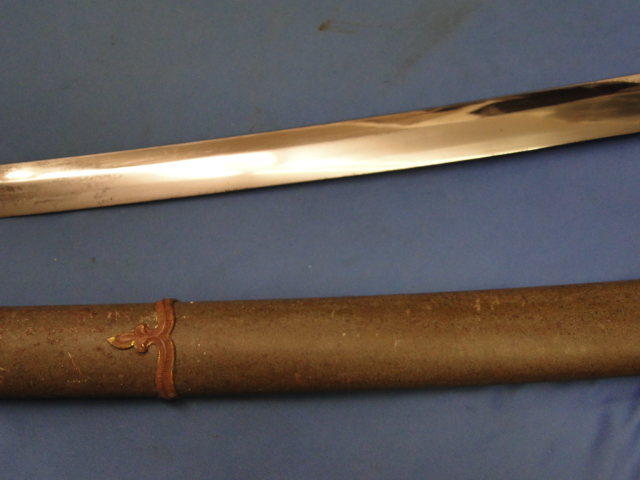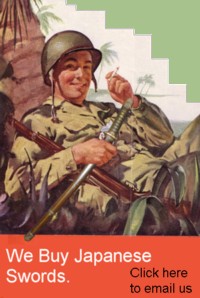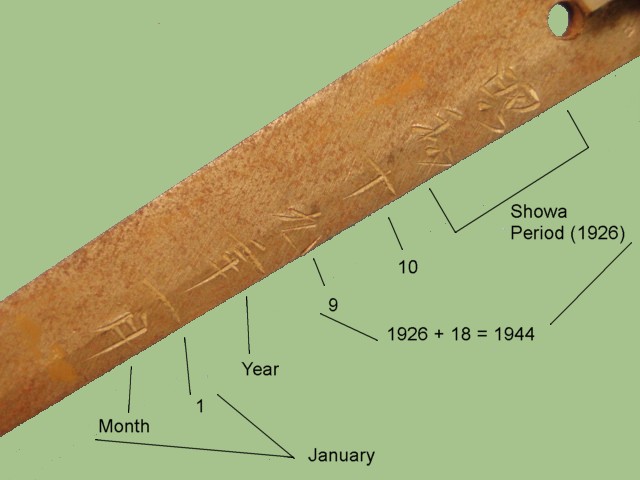SAMURAI SWORD 52 - WWII KATANA BY NOBUMITSU -
This is a Japanese Imperial Army sword. As issued to officers during WWII. The handle is wrapped in the traditional
green cloth. The pommel has a metal cap. The Tsuba is standard WW2 issue. The scabbard is painted green and has a
single suspension ring.
When the sword is placed in the scabbard, a little hook activates and locks the blade in place. This is a safety device
so the sword does not fall out.

This photo shows the Samuraui sword taken out of the scabbard. The sword has a slight curve, which is the signature
of the Samurai blade. The original polish remains. No major damage. Some surface rust spots but the edge does
not have any nicks.


|
The Samurai sword has a very rich history. The sword has been manufactured for several centuries and continues
to be produced today. The sword represented more than just a weapon. It was the soul of the Samurai warrior.
When attempting to identify the type of sword you have It is important to keep in mind that the fittings of
a sword (scabbard, handle, crossguard. etc.) may be identical from one sword to another. The reason why is
because during WWII the same fittings were used in all Army swords, Navy swords, etc. Armed forces are all
about uniformity. They strive to make everything the same.
This is the reason why a sword cannot be identified merely by its external appearance.
Understanding the different components that make up the Samurai sword is the first step in figuring out the
type of sword you have. That is the reason why we have created the
Understanding the Samurai sword section as a means to
provide a novice with the basic knowledge to start the path of determining the questions everyone has;
who made the sword, how old it is nad how much it is worth.
|

When the handle is removed traces of the filings are visible in the form of lines at an angle. The Habaki is of standard
construction for the period.
A close up of the handle reveals a wrapping job that remains tight. The pommel cap has openings on the side. Flowe and
leaf images are applied to the front, top and back. A hole is found in the pommel, this is used as a means to attach the
lanyard loop to the pommel.

Some of the pommel rings are very basic. The one shown here is very nicely decorated. The pommel cap also has a nice
pebbling effect all around the main body.
The handle has a wooden core that is wrapped in white ray skin. A set of Menukis is found on the handle. One for each
side. The shape of the Menuki consists of three flowers in a row. That was the standard military issue during WWII.



The Tsuba is of late war construction. The center body is solid as opposed to being hollowed. A flower is placed on each
corner. The spacers (O-Seppa) are visible from a top view. The metal ring placed at the base of the handle is also
decorated with the same flower and leaf design as the pommel cap.
The base ring serves the purpose of holding the locking release mechanism. This is a metal button that when depressed it
releases the lock that holds the blade attached to the scabbard. The sword can then be pulled out.

|
This page is a recognition and identification guide for Samurai swords.
Multiple detailed photos of a specific sample are provided. Descriptions point
out clearly defined points that should be noted.
One of the most commonly asked questions is "How much is my Samurai Sword worth?".
A price guide is included here to address this question. The value of the swords is
reviewed over a period of several years. A trend can be observed. The present worth
of the edge weapons in the collector's market is illustrated.
This service is provided free of charge to the visitor/enthusiast courtesy of
MilitaryItems.com,
a company dedicated to the preservation of military history and to providing quality
military antiques and collectibles to museums, institutions and the general public.
|
|



|
WE BUY JAPANESE SWORDS - All types of Japanese edge weapons. Whether it is a WWII era Samurai sword or an
older type of blade.
The process gets started by you sending us an
Email .
We will respond to your inquiry normally within 24 hours and in many cases much faster.
We can tell you what you have, what it is worth and how much we can pay you.
One sword or an entire collection -
Email Us .
|
 |


The date information is written on the tang. The sword is from the Showa period which starts in 1926 under
Emperor Hiroito.

The date translate to January of 1944. Notice that the tang has a single hole. This is an indication that the sword
was never shortened. It retains the original size as when it was created. The end of the Tang has a round appearance.

The signature of the master. His name was Nobumitsu and he was a knwon sword maker during WWII. A number 41 and a
couple other small characters are written just below the signature. These are either production numbers or arsenal
inventory numbers.

This is a view of the entire tang where the master's signature has been applied.

By the Numbers
It is next to impossible to determine the exact number of Samurai swords that were produced and issued to
Japanese soldiers during the war. However, thanks to the record keeping maintained by the US Armed Forces,
it is possible to estimate how many swords were actually shipped home.
 |
There were over 500,000 Samurai swords were brought back home as souvenirs from the war.
There are several caviats to this number.
|
 |
For example, some soldiers took souvenirs and shipped them home circumbenting the established process.
Some of the swords were brought back inside duffle bags without anyone knowing except for the soldier who
captured the sword. This fact would clearly affect the final count.
The number also does not account for swords that were taken by Allied soldiers from other countries.
Collecting Samurai swords
Collecting Samurai swords is a field that has been growing since the days the GI's rummaged around Asia
bringing back military souvenirs. Japanese soldiers carried many of these swords when they went to
battle. Once the soldier was killed or captured, the Americans would take the edge weapons as war trophies.
Eventually all these pieces came back to the United States where military history enthusiasts began to collect them.
 |
In trying to determine if you should collect Samurai swords there are certain factors that should be
considered.
The adjacent table outlines some of the advantages and disadvantages of collecting the Samurai swords.
|
 |
This Samurai Sword may be currently reproduced.
It is becoming more difficult to be able to tell the fake ones from the real ones because
the quality of the reproductions is improving. The collector must become familiarized with
the construction style and materials employed in the manufacturing of this item.
Attention to the details is critical in order to be able to determine the authenticity of
the collectible.
If you have an interest is seeing other Japanese Samurai swords, you can do so by going to our
Japanese Samurai Swords Price Guide
identification guide. Where we cover Samurai swords from all periods.
|





